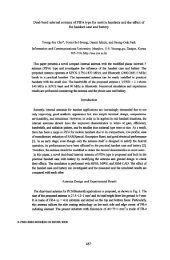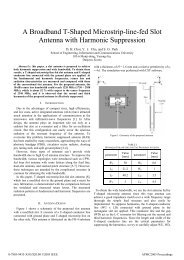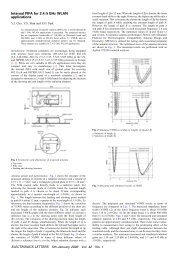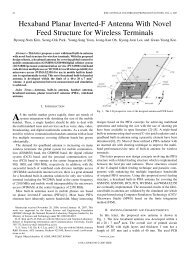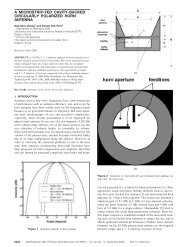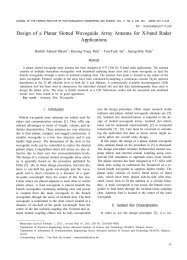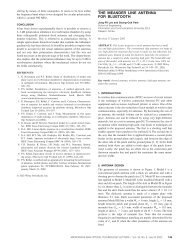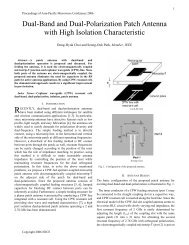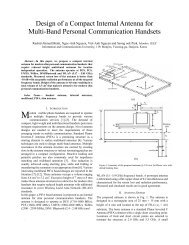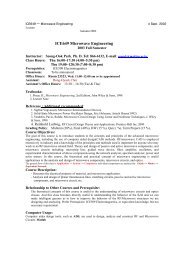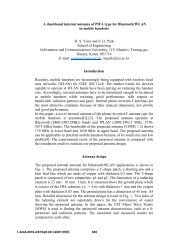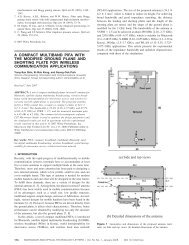Optoelectronic and microwave transmission characteristics of indium ...
Optoelectronic and microwave transmission characteristics of indium ...
Optoelectronic and microwave transmission characteristics of indium ...
You also want an ePaper? Increase the reach of your titles
YUMPU automatically turns print PDFs into web optimized ePapers that Google loves.
412 IEEE TRANSACTIONS ON ADVANCED PACKAGING, VOL. 29, NO. 3, AUGUST 2006<br />
Fig. 7. <strong>Optoelectronic</strong> <strong>characteristics</strong> <strong>of</strong> flip-chip-bonded VCSEL arrays<br />
(a) I–V curves <strong>and</strong> (b) L–I curves. (Color version available online at<br />
http://ieeexplore.ieee.org.)<br />
<strong>of</strong> the Ag/In interface is analyzed. Fig. 5 shows the energy<br />
dispersive spectroscopy (EDS) elemental distribution mapping<br />
<strong>of</strong> diffused Ag in an <strong>indium</strong> solder. It can be inferred that the<br />
Ag atoms are deeply diffused into the <strong>indium</strong> solder, despite<br />
the small amount <strong>of</strong> Ag involved. In general, the Ag diffuses<br />
rapidly into <strong>indium</strong> via an interstitial mechanism, <strong>and</strong> <strong>indium</strong><br />
diffuses into silver through grain boundaries with a diffusion<br />
coefficient <strong>of</strong> 2.4 10 m s <strong>and</strong> an activation energy<br />
<strong>of</strong> 0.42 eV [8]. Therefore, immediately after deposition, the<br />
Ag layer interacts with the <strong>indium</strong> to form a AgIn compound<br />
layer due to the high interdiffusion coefficient [9]. Formation<br />
<strong>of</strong> a AgIn compound was identified from scanning electron<br />
microscopy (SEM) <strong>and</strong> EDS analyses.<br />
B. <strong>Optoelectronic</strong> Characteristics <strong>of</strong> Flip-Chip-Bonded<br />
VCSEL Array<br />
Fig. 6 shows the experimental setup used to measure the light<br />
output power <strong>of</strong> the flip-chip assembled VCSEL array. The <strong>characteristics</strong><br />
<strong>of</strong> the VCSEL arrays that were flip-chip bonded using<br />
Fig. 8. Measured (a) insertion loss (S ) <strong>and</strong> (b) return loss (S ) for <strong>indium</strong><br />
bump <strong>and</strong> Ag-coated <strong>indium</strong> bump (total CPW line length: 4 mm). (Color<br />
version available online at http://ieeexplore.ieee.org.)<br />
either a Ag-coated <strong>indium</strong> bump or an uncoated <strong>indium</strong> bump<br />
are compared by means <strong>of</strong> – <strong>and</strong> – inspections. In this<br />
paper, two-channel VCSEL arrays operating at 850-nm wavelength<br />
range with rates <strong>of</strong> 2.5 Gb/s were used. Fig. 7(a) shows<br />
the – curves <strong>of</strong> the flip-chip-bonded VCSEL. It inferred that<br />
the resistance <strong>of</strong> a Ag-coated <strong>indium</strong> bump is slightly lower<br />
than that <strong>of</strong> the uncoated <strong>indium</strong> bump. The – <strong>characteristics</strong><br />
<strong>of</strong> the VCSELs were compared in Fig. 7(b). The light output<br />
power <strong>of</strong> the Ag-coated <strong>indium</strong> bump is higher than that <strong>of</strong> the<br />
<strong>indium</strong> bump. In addition, the Ag coating on the <strong>indium</strong> bumps<br />
decreases the threshold current <strong>of</strong> the VCSEL from 50 to 43 mA.<br />
Therefore, the – <strong>and</strong> – curves indicate that the Ag-coated<br />
<strong>indium</strong> bumps are superior to the uncoated <strong>indium</strong> solder bumps<br />
with regard to optical <strong>and</strong> electrical performances.<br />
C. Characterization <strong>of</strong> a Flip-Chip Interconnect at<br />
Frequencies Up to 40 GHz<br />
The RF <strong>and</strong> <strong>microwave</strong> <strong>characteristics</strong> <strong>of</strong> the flip-chipbonded<br />
CPW samples were analyzed for the entire frequency




